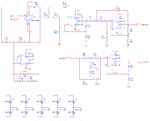LvW
Advanced Member level 6

heart beat monitoring circuit
Highpass: Do you need a highpass of 2nd order ? If not, there is a 1st order topology which is best suited for low frequencies: A simple RL-highpass scheme with active simulation of the inductor using two opamps (gyrator principle using the impedance converter structure).
Notch: The best circuit - as far as dimensioning is concerned - is a structure based again on the impedance converter principle. However, two opamps are required. Two other one-opamp topologies are based on the multifeedback-bandpass filter. If necessary I could send you a schematic.
aredhel said:I only know of the Wein Bridge and the Twin-T ... been looking for other notch topologies. Could you recommend some?
Highpass: Do you need a highpass of 2nd order ? If not, there is a 1st order topology which is best suited for low frequencies: A simple RL-highpass scheme with active simulation of the inductor using two opamps (gyrator principle using the impedance converter structure).
Notch: The best circuit - as far as dimensioning is concerned - is a structure based again on the impedance converter principle. However, two opamps are required. Two other one-opamp topologies are based on the multifeedback-bandpass filter. If necessary I could send you a schematic.



